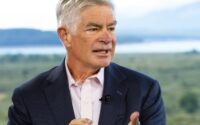Why This is the Most Reckless Fed Ever, and What I Think the Fed Should Do to Reverse and Mitigate the Effects of its Policy Errors
The Fed’s credibility shifted from Inflation Fighter under Volcker to Wealth Disparity Creator and Inflation Arsonist under Powell. And everyone knows it.
By Wolf Richter for WOLF STREET.
As stunningly and mindbogglingly bizarre as this sounds, it’s reality: Inflation has been spiking for over a year, getting worse and worse and worse, while the Fed denied it by saying, well, the economy is recovering, and then it denied it by saying, well, it’s just the “base effect.” And when inflation blew out after the base effect was over, the Fed said it was a “transitory” blip due to some supply chain snags. And when even the Fed acknowledged last fall that inflation had spread into services and rents, which don’t have supply chains all over China, it conceded that in fact there was an inflation problem – the infamous pivot.
By which time it was too late. The “inflationary mindset,” as I called it since early 2021, had been solidly established.
I’ve been screaming about it for over a year. By January 2021, I screamed that inflation was spreading broadly into the economy. By February 2021, I screamed that inflation was spreading into the service sector. And I screamed about inflation in the transportation sector. By March 2021, it was obvious, even to me, that “something big has changed,” based on the fact that consumers were suddenly willing to pay totally crazy prices for used cars, when many of them could have just driven what they already had for a while longer, which would have brought the market down, and with it prices.
But no, consumers suddenly started paying whatever. And I documented how companies were able to pass on higher prices because suddenly everyone was willing to pay whatever. And by April, producer prices were blowing out, and companies were able to pass them on, no problem. And in April, I started using a term for this phenomenon: the “inflationary mindset” and how it had suddenly become established.
By that time in April, it was clear beyond a reasonable doubt that inflation would become a massive problem because the inflationary mindset had been established with companies paying higher prices, confident they could pass them on, and with consumers willing to pay whatever.
And all along – despite our screaming in the trenches – the Fed stuck to its “transitory” nonsense, while continuing to throw huge quantities of gasoline on the already raging fire, by interest rate repression and money-printing, as only a true inflation arsonist would.
And then when the Fed finally could no longer brush it off in the fall of 2021, as inflation continued to get worse and worse, the Fed made its infamous pivot, verbally. But it continued to pour the gasoline on the fire.
The Fed eventually started to slowly dial back the amount of gasoline it was still pumping directly on the fire: It reduced QE gradually instead of ending it cold turkey right then and there when it did the pivot. And it put rate hikes on the table for 2022, instead of hiking them on the spot. And inflation got worse and worse.
Policy error after policy error – with massive consequences. QE is just now winding down, but the Fed’s policy rates are still at near 0%. And CPI inflation has shot up to 7.9%.
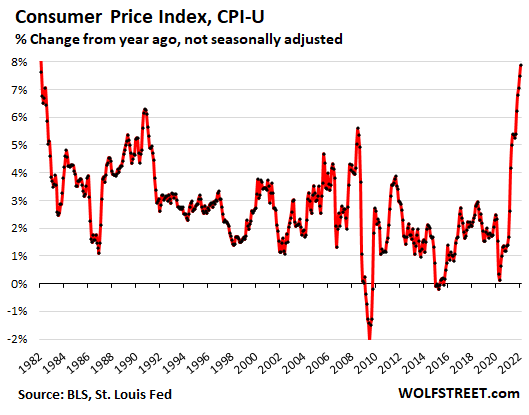
But a lot of individual categories of prices have totally blown out, particularly those where the less well-off spend a lot of their money. For example:
- Used Cars: +41.2%
- Gasoline: +38.0%
- Gas Utilities: +23.8%
- Beef and veal: +16.2%
- Pork: +14.0%
- Poultry: 12.5%
- New Cars: +12.4%
- Eggs: +11.4%
- Fresh fruits: +10.6%
- Fish and seafood: +10.4%
- Electricity: +9.0%
The most reckless Fed ever.
So now we have this crazy situation, where the Fed is still repressing the effective federal funds rate (EFFR) to 0.08% while CPI inflation is raging at 7.9% and will likely go over 8% soon.
Back in the days of high inflation – the 1970s and 1980s – there were moments when CPI inflation was at 7.9%, crossing it either on the way up or crossing it on the way down.
But at those moments when CPI was 7.9%, the EFFR was:
- Oct 1973, inflation shooting higher, EFFR = 10.8%
- Sep 1975, inflation declining: EFFR = 6.2%
- Aug 1978 inflation shooting higher: EFFR = 8.0%
- Feb 1982, inflation declining: EFFR =14.8%
And this is what this absurdity looks like, going back to 1955, when the EFFR data begins. Red line = CPI; purple line = EFFR. This chart documents why this is the most reckless Fed ever:
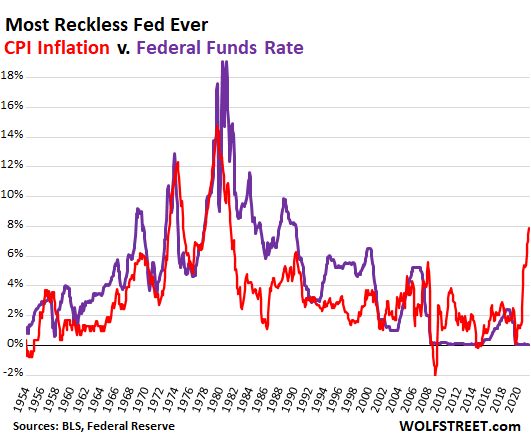
The “real” EFFR: nothing ever came close in recklessness. The EFFR minus CPI produces the inflation adjusted or “real” EFFR. The real EFFR is now -7.8%, the lowest and worst in recorded history, another chart that documents why this is the most reckless Fed ever:
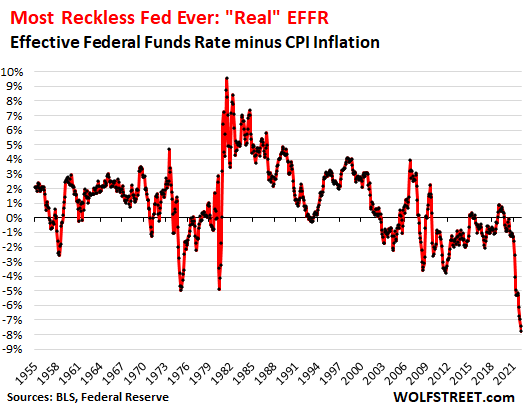
The Fed’s credibility as inflation arsonist is going to be tough to change.
The Volcker Fed, back in the early 1980s, earned the credibility as inflation fighter. This has benefited the economy for nearly 40 years. It even got the Fed through the money printing spree during and after the Financial Crisis without triggering rampant inflation of the type we now have.
But by pumping large amounts of gasoline on already raging inflation for over a year – when lots of people, including me, were screaming about it because it was so obvious – the Fed has wiped out its credibility as an inflation fighter, and has instead become the world’s biggest inflation arsonist. And everyone knows it.
No one is going to believe when the Fed says it’s serious about tamping down on inflation. Inflation is in part a psychological phenomenon – the “inflationary mindset,” as I call it – and the Fed has blown its credibility. So good luck dealing with it.
The Fed’s meme that money-printing helps the working people turned out to be BS.
The Fed has been couching its crazy monetary policies and refusal to deal with inflation as way of helping the lower end of the labor market. But that is patently BS. And the Fed knew it. This blowout of inflation has resulted in hourly earnings falling behind CPI inflation for the 11th month in a row, compared to the prior year, starting in April 2021.
In other words, “real” earnings declined for the 11th month in a row, thanks to the Fed’s raging inflation – despite big wage increases and the tightest labor market in our generation. Inflation hits those people the hardest that make their living from actual work, rather than those who are sitting on a pile of assets.
That is the price of interest-rate repression and money printing, and the price is being paid by people who’re working for a living.
But wait… there was a small group of huge beneficiaries from the Fed’s policies.
The Fed has long had as its official monetary policy goal the “wealth effect.” The wealth effect has been promoted in numerous Fed papers, including by Janet Yellen in 2005, when she was still president of the San Francisco Fed. Under this doctrine, the Fed used monetary policies (interest rate repression and QE) to inflate asset prices that make asset holders (the already wealthy) even wealthier. The idea is that the even-wealthier spend a little of this money, and that this will trickle down somehow.
What this wealth effect doctrine has accomplished – and with exponential efficiency during the crazed QE and interest rate repression since March 2020 – is the greatest wealth disparity ever.
My “Wealth Effect Monitor” is based on the Fed’s data about household wealth (defined as assets minus debts) by wealth category for the “1%,” the “2% to 9%,” the “next 40%,” and the “bottom 50%.” My Wealth Effect Monitor takes the Fed’s data down to the per-household level.
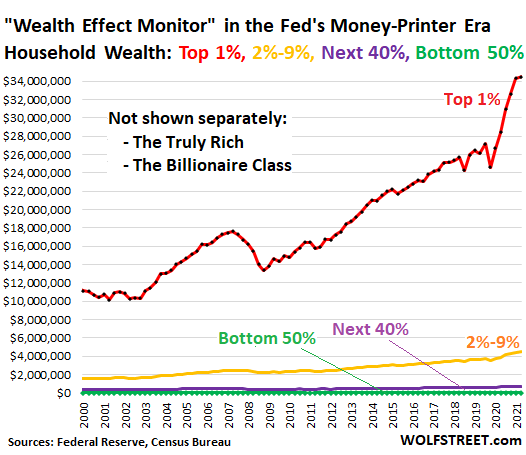
What the Fed should do now to mitigate the effects of its reckless policy errors.
The Fed cannot undo the enormous policy errors it has committed over the past two years. But it can end them going forward, it can mitigate the devastating effects now playing out in the economy, and it can prevent those effects from spiraling totally out of control.
So this isn’t what the Fed should have done – that’s a different story – but what it should do now, starting after its meeting on March 16:
Start unloading the balance sheet (Quantitative Tightening) now at a rate of something like $200 billion a month, by both, allowing all maturing securities to roll off without replacement, and by selling outright the securities with the longest remaining maturities, such as 30-year bonds with 29 years left to run; they need to go first.
Run QT in the foreground, with the stated and explicit purpose of driving up long-term yields. Running QT in the “background” on automatic pilot, as Powell said, is just goofy. The purpose of QT is to push up long-term yields, just as the purpose of QE was to push down long-term yields. The purpose is to steepen the yield curve while the Fed is hiking short-term rates.
Specifically, sell MBS outright. MBS have maturities of 15 years and 30 years. Holders such as the Fed receive pass-through principal payments from mortgage payments and when mortgages are paid off, such as in a refi or the sale of a home. In a housing market with declining mortgage rates, refis and home sales are booming, and these pass-through principal payments turn into torrents, and the MBS on the Fed’s balance sheet would fall rapidly.
But in this rising interest rate environment, the housing market slows, and refis slow, and the pass-through principal payments slow to a trickle. This is why the Fed should sell its MBS outright to get them off the balance sheet entirely in a couple of years.
Time the market with the sales of securities: Every time long-term yields decline a little, use the opportunity to sell even more securities. Any good investor trying to unload debt securities would do that. This would keep the yield curve steep.
Raise short-term rates by 100 basis points on March 16, to communicate in a way that everyone would understand that the Fed is serious about ending its reputation as inflation arsonist and regaining its ruined credibility as inflation fighter. Then continue raising rates at smaller increments, such as 50 basis points at every meeting this year. That would bring its policy rate up to about 4.5% by year-end, with inflation likely over 8%.
Front-loading the rate hikes and breaking that “inflationary mindset” might help get inflation back down sooner. Dilly-dallying around will drag this out and let inflation get worse and worse, with higher and higher interest rates needed to have any impact on inflation.
Officially abandon the “Fed put.” Let markets find their own way. Markets are good at that. Sell-offs bring a much-needed cleansing of excesses and lots of opportunities. Markets need to be allowed to function properly as markets do.
Remove QE from the toolbox once and for all. QE is a destructive policy that creates wealth disparity, asset price inflation, and ultimately consumer price inflation. Its effects on the real economy are minimal. It needs to be thrown in the trash.
Instead, use the Standing Repo Facilities if the Treasury market locks up. The Fed has likely for this purpose re-established the repo facilities in 2021, after shutting them down in 2008. No QE needed.
Allow debt restructurings and bankruptcies to resolve excessive debts in the economy. If companies have too much debt, they need to restructure this debt at the expense of investors. This is a healthy essential process of capitalism. For two recessions in a row, the Fed has stopped that process from playing out. Now there are huge excesses, further fueled by years of ultra-low interest rates. US laws and markets are well-suited to sort this out.
But instead, Powell will try to engineer a soft landing.
Yup, the Fed is going to raise rates and it’s going to reduce its balance sheet. But they will pussyfoot around and insist on being able to achieve a soft landing by not doing enough, and the longer they pussyfoot around, the more entrenched inflation will get, and the longer it will drag on, and the harder it will be to dislodge it, and the longer the Fed will ultimately struggle to contain it.
Enjoy reading WOLF STREET and want to support it? Using ad blockers – I totally get why – but want to support the site? You can donate. I appreciate it immensely. Click on the beer and iced-tea mug to find out how:

Would you like to be notified via email when WOLF STREET publishes a new article? Sign up here.
![]()
[ad_2]
Source link


